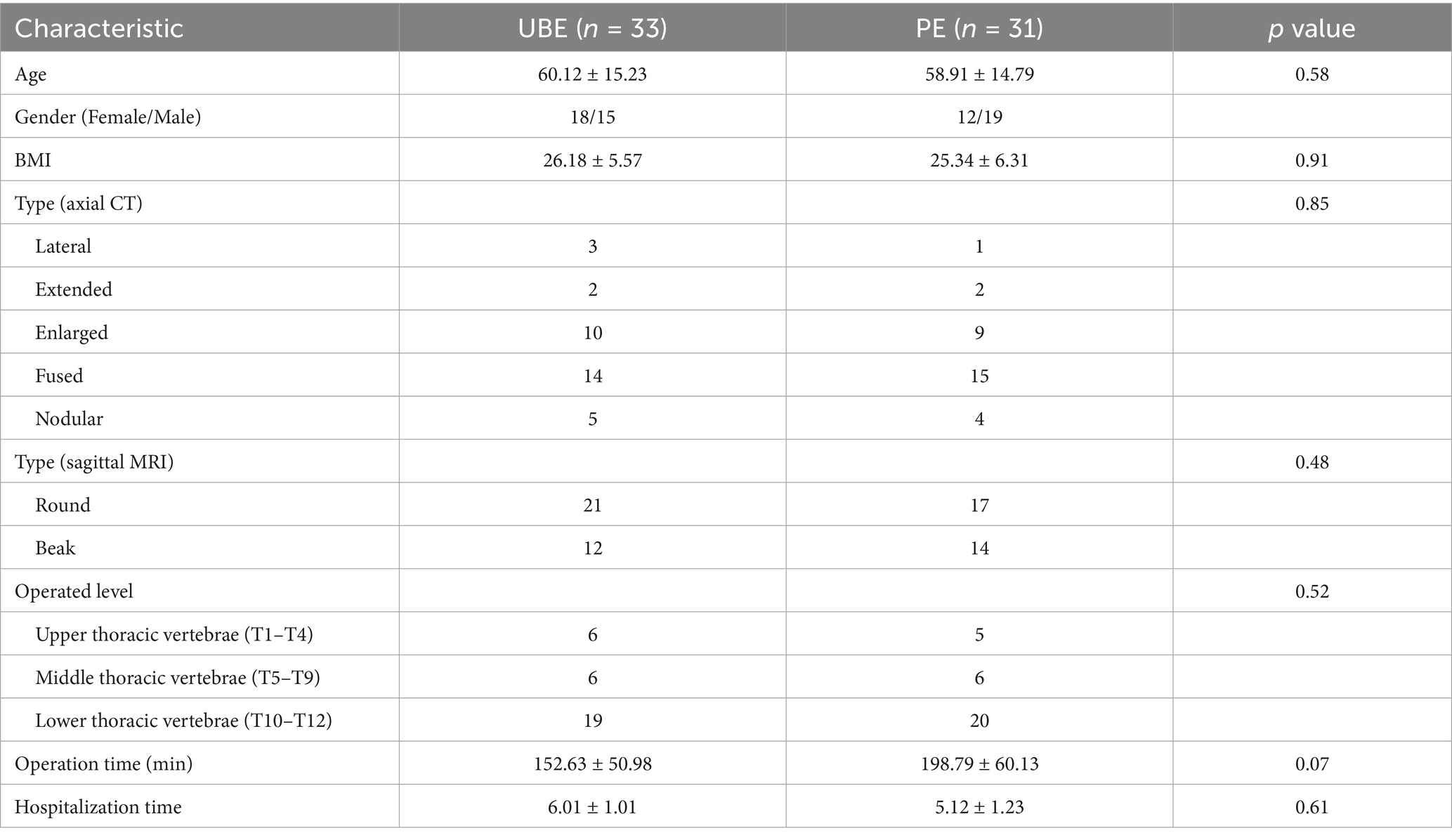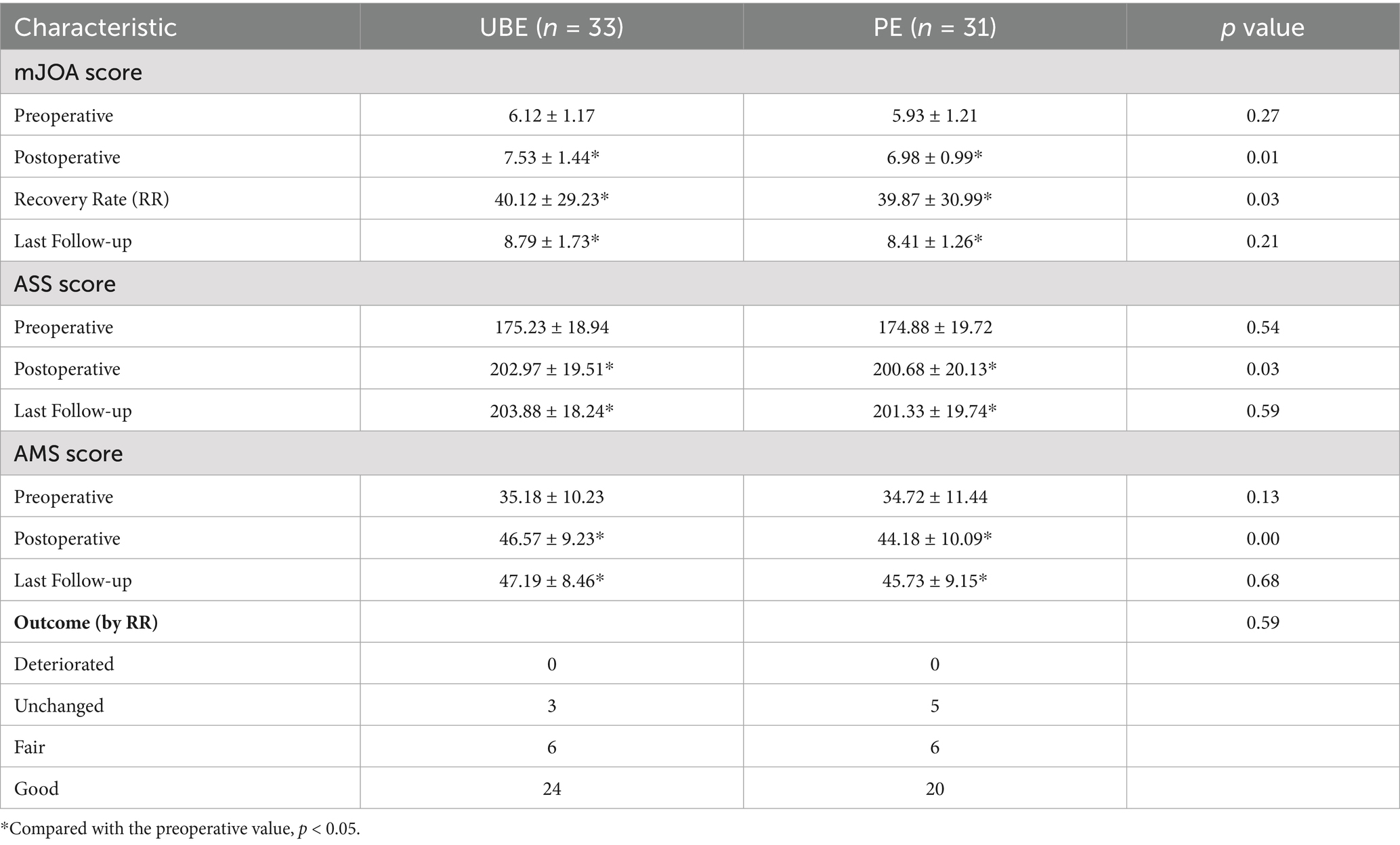- Department of Mini-Invasive Spinal Surgery, The Third People's Hospital of Henan Province, Zhengzhou, China
Purpose: The purpose of this study was to compare the clinical efficacy and safety of the percutaneous endoscopic (PE) technique and the unilateral biportal endoscopic (UBE) technique for the treatment of thoracic ossification of the ligamentum flavum (T-OLF).
Methods: This study retrospectively analyzed T-OLF patients who received endoscopic surgical treatment from January 1, 2020, to December 31, 2022. Patients were divided into a PE group and a UBE group according to the surgical method. The basic information of the patients was recorded. Preoperative and postoperative neurological status was evaluated using the mJOA score, American Spinal Injury Association (ASIA) sense score (ASS), and ASIA motor score of the lower extremities (AMS). The mJOA recovery rate (RR) was also calculated. T-OLF can be diagnosed on the basis of sagittal Magnetic Resonance Imaging (MRI) and axial Computed Tomography (CT).
Results: A total of 64 patients were followed for an average of 12–24 months. 33 patients underwent UBE surgery, and 31 patients underwent PE surgery. There was no significant difference in baseline characteristics between the two groups (p > 0.05). Neurological function was significantly improved in both groups after surgery. Compared with the PE group, the UBE group experienced better postoperative clinical efficacy, and the difference was statistically significant (p < 0.05). Postoperative CT and MRI revealed that the degree of spinal cord compression in patients in the UBE and PE groups was relieved. 4 patients in the PE group and 1 patient in the UBE group had dural sac tears. 3 patients with upper thoracic vertebrae in the PE group exhibited transient neurological deficits. These complications did not cause serious consequences.
Conclusion: For patients with T-OLF, both UBE and PE can effectively alleviate nerve compression and relieve symptoms. UBE uses two channels for observation and operation, leading to more effective and safer clinical outcomes.
Introduction
Thoracic ossification of the ligamentum flavum (T-OLF), which leads to thoracic spinal canal stenosis, was first reported by Le Double in 1912 (1). T-OLF is a relatively rare spinal disease worldwide that is most commonly found in East Asian countries and typically affects the lower thoracic spine (2, 3). The average age of onset is between 50 and 60 years (4). The rarity and insidious onset of T-OLF often lead to delayed diagnosis. Therefore, by the time clinical symptoms present, most patients need surgical intervention to relieve spinal cord compression (5). Previous studies have demonstrated that the duration of preoperative symptoms, the severity of spinal cord compression, and changes in MRI signals in the spinal cord influence surgical outcomes (6, 7). Consequently, early and thorough decompression is essential for effective treatment. Posterior laminectomy is widely regarded as the standard treatment for T-OLF (8). However, excessive disruption of the muscle–ligament complex and facet joints during this procedure can lead to complications, including thoracic back pain and local kyphotic deformity, which may adversely affect patient outcomes (9). Although fusion surgery can prevent local kyphotic deformities, it does not alleviate thoracic back pain and may, in fact, contribute to adjacent segment disease (10).
With the development of minimally invasive technology, endoscopic surgery for T-OLF has demonstrated promising outcomes (11, 12). Percutaneous endoscopic (PE) surgery for T-OLF has been documented in multiple studies (13, 14). Endoscopic instruments can minimize damage to paravertebral muscles and bone structures, thereby advancing the application of endoscopic technology in the treatment of thoracic spine diseases. Unilateral biportal endoscopic (UBE) decompression is a novel technique performed using a percutaneous endoscope (15). Unlike PE uniaxial endoscopic approaches, it offers a greater operating range, enhanced flexibility, and a wider, clearer surgical field and has been extensively utilized in the treatment of lumbar spinal stenosis (16).
However, few reports exist on the use of UBE for thoracic spinal canal decompression, and few studies are available that compare the effectiveness and safety of these two endoscopic techniques for the treatment of T-OLF. Therefore, the purpose of this study was to compare the clinical efficacy and safety of two spinal endoscopic techniques for the treatment of T-OLF.
Methods
Patients
A total of 64 patients with T-OLF who underwent thoracic spine surgery at our institution from January 1, 2020, to December 31, 2023, were analyzed. The patients were divided into two groups according to the surgical method used: the UBE group (n = 33) and the PE group (n = 31). All patients met the clinical and radiological standards for T-OLF and underwent surgery performed by an experienced spinal team. This study was approved by the Medical Ethics Committee of the Third People’s Hospital of Henan Province, and all the patients provided informed consent. The minimum follow-up time was 1 year.
The inclusion criteria were as follows: (1) CT reveals ossification of the ligamentum flavum in a segment of the thoracic spine, and MRI reveals compression of the thoracic spinal cord; (2) unilateral or bilateral sensory and motor disorders of the body and lower limbs, with hyperreflexia of the lower limbs and positive pathological signs; and (3) physical signs match the imaging symptoms.
The exclusion criteria were as follows: (1) patients with tumors, severe organic diseases, severe cardiovascular or cerebrovascular diseases, hemorrhagic diseases, etc.; (2) patients with spinal instability or deformity; (3) patients with thoracic ossification of the posterior longitudinal ligament, thoracic disc herniation or other thoracic diseases caused by ventral spinal cord compression; and (4) patients with incomplete follow-up data.
Surgical methods
UBE
The operation was performed with conventional intubation under general anesthesia. The patient was placed in the prone position with a suitable body position pad. By adjusting the operating table, the intervertebral space of the target segment was made perpendicular to the ground as much as possible. Taking the position of ossification of ligamentum flavum as the horizontal line, a longitudinal incision was selected. The operation channel and observation channel are approximately 2.0 cm away from the midline of the spinous process, the distal end is used as the operation channel, the proximal end is used as the observation channel, and the distance between the midpoint of the two incisions is approximately 3.0 cm (Figure 1a). After routine disinfection and draping with a waterproof membrane, an operating channel (approximately 1.0 cm incision) and an observation channel (approximately 5.0 mm incision) are established, with the tips of the cannulas converging on the surface of the lamina (Figure 1b). After confirming the proper positioning of the cannulae under C-arm fluoroscopy, the visual field was located under the endoscope. A 90° plasma radiofrequency electrode is then used to expose the lamina and the base of the spinous process. Next, a grinding drill is used to create a depression. Anteroposterior and lateral fluoroscopy were performed to verify the correct segment and confirm the starting position. A 4.0 mm grinding drill was subsequently used to quickly remove the superficial lamina and cancellous bone. The lamina at the head (Figure 1c) and tail (Figure 1d) were removed to the starting and ending points of the ligamentum flavum, and the lateral boundary extended to the medial edge of the facet joint. The grinding range of the base of the spinous process should ensure that the access of instruments is not blocked. Next, a grinding drill was used to adequately thin the ossified ligamentum flavum (Figure 1e). Finally, a nerve hook was used to separate the deep surface of the ossified ligamentum flavum (Figure 1f), and the ossified ligamentum flavum was gradually removed with a Kerrison rongeur. If the ossified ligamentum flavum strongly adheres to the dura mater or if there is ossification of the dura mater, it can be adequately thinned using a grinding drill and circumferentially dissected for floating treatment (Figure 1g). If there is hypertrophic adhesion of the bilateral facet joints, they can first be thinned with a grinding drill, and then decompression of the nerve root canal can be performed using a Kerrison rongeur. Finally, complete decompression of the spinal canal was ensured (Figure 1h), hemostasis was obtained, a drain was placed, the endoscope was removed, the wound was sutured, and the operation was complete (Figure 2).
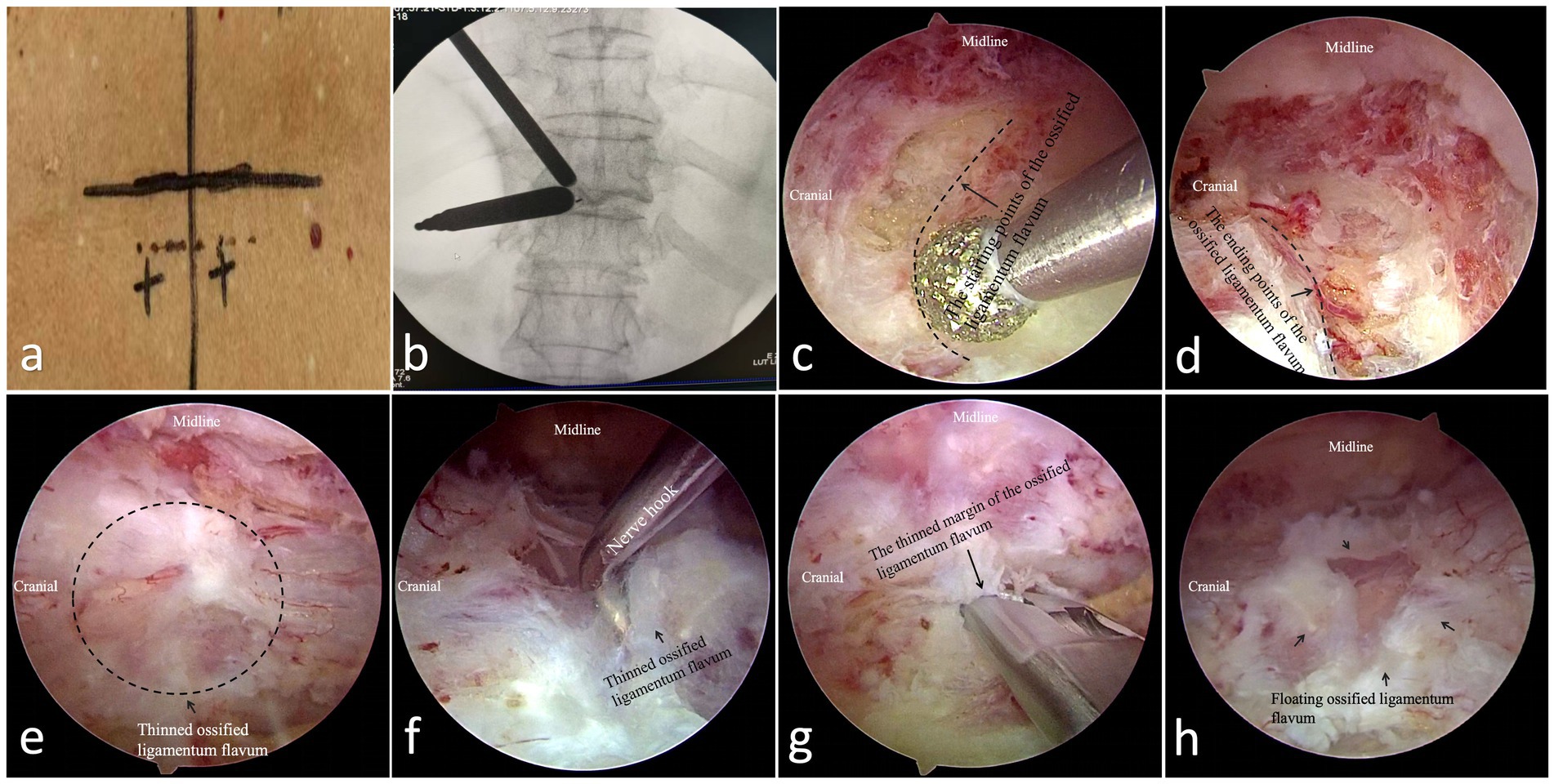
Figure 1. (a) Lineation-on-body; (b) Cannulas converging on the surface of the lamina; (c) The lamina at the head; (d) The lamina at the end; (e) The thinned ossified ligamentum flavum; (f) Use a nerve hook to separate the deep surface of the ossified ligamentum flavum; (g) Remove the ossified ligamentum flavum with a Kerrison rongeur; (h) Complete decompression of the spinal cord.
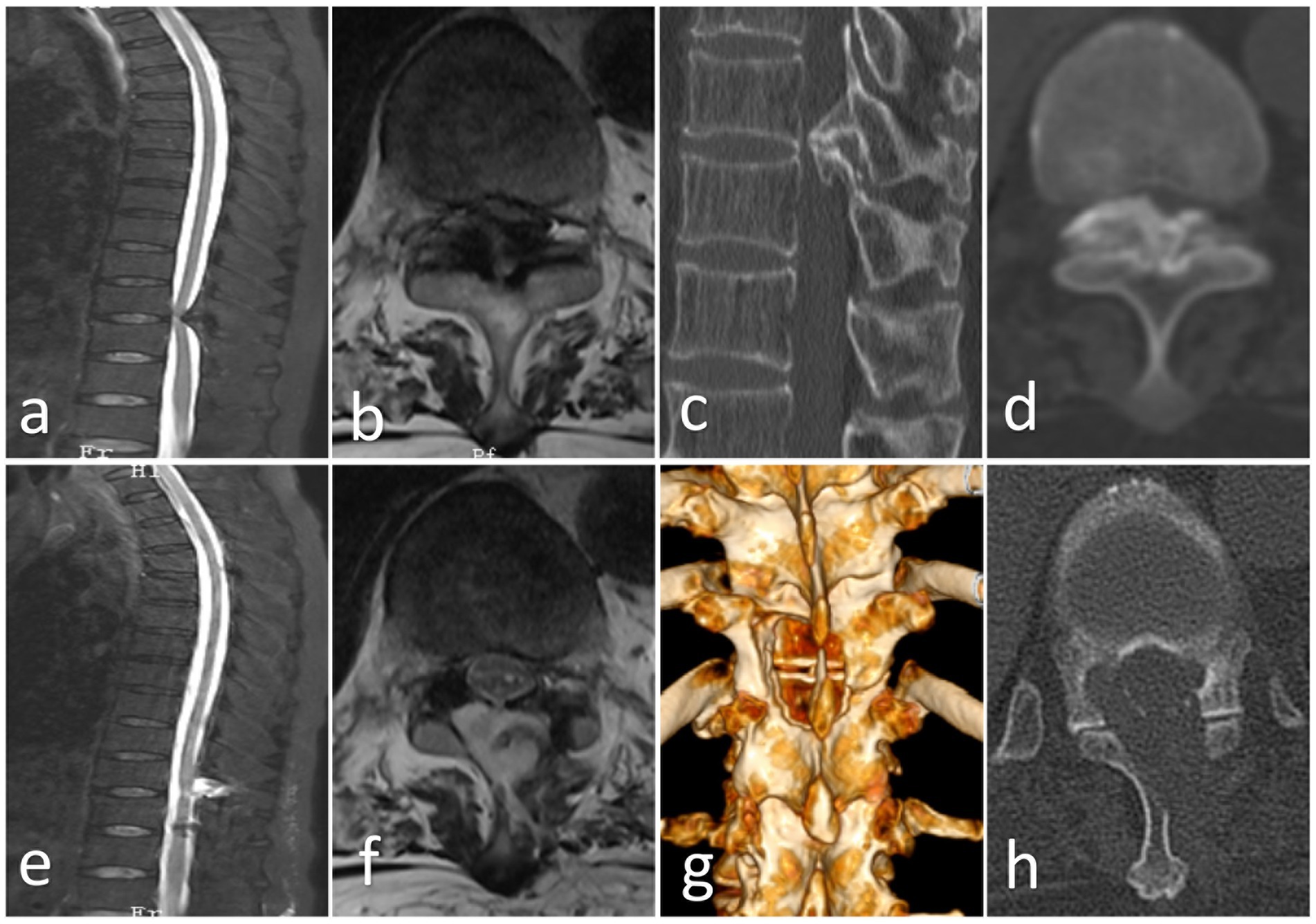
Figure 2. (a,b) Preoperative MRI shows ossification of the thoracic ligamentum flavum (Round); (c,d) Preoperative CT shows severe ossification of the thoracic ligamentum flavum (Fused); (e,f) Postoperative CT shows that the ossification has been removed and spinal cord decompression has been successful, and a small amount of cerebrospinal fluid leaked out; (g,h) Postoperative CT and 3D reconstruction show that the spinal canal has been opened and the ossification has been removed.
PE
The patient is positioned prone, and anesthesia is administered using local anesthesia with intravenous adjuncts. Under fluoroscopic guidance with a C-arm, the target segment is localized and marked on the skin surface. After routine disinfection and draping with waterproof protection, an 18-gauge puncture needle was used to puncture at the marked point. The target point is located at the junction of the spinous process and the lamina. The incision was enlarged, the needle core was removed, and the guide wire was inserted. The dilator sheath was sequentially inserted, and the “U”-shaped beveled working sheath was finally placed. The position of the “U”-shaped sheath was confirmed under fluoroscopy using the C-arm. The fully visualized endoscope was inserted. First, a plasma radiofrequency electrode and nucleus pulposus forceps were used to expose the ipsilateral lamina and the base of the spinous process. Next, an eccentric ring was used to address the ipsilateral lamina and the base of the spinous process, and then the contralateral bone was removed through the roof, ranging from the head and tail to the starting and ending points of the ligamentum flavum, and extended bilaterally to the medial aspect of the superior articular processes. The deep lamina and ossification were subsequently thinned with a grinding drill, and the thinned ossification was removed with an Endo Kerrison rongeur. Finally, the bleeding was stopped fully, drainage was performed, the endoscope was removed, the wound was sutured, and the operation ended (Figure 3).
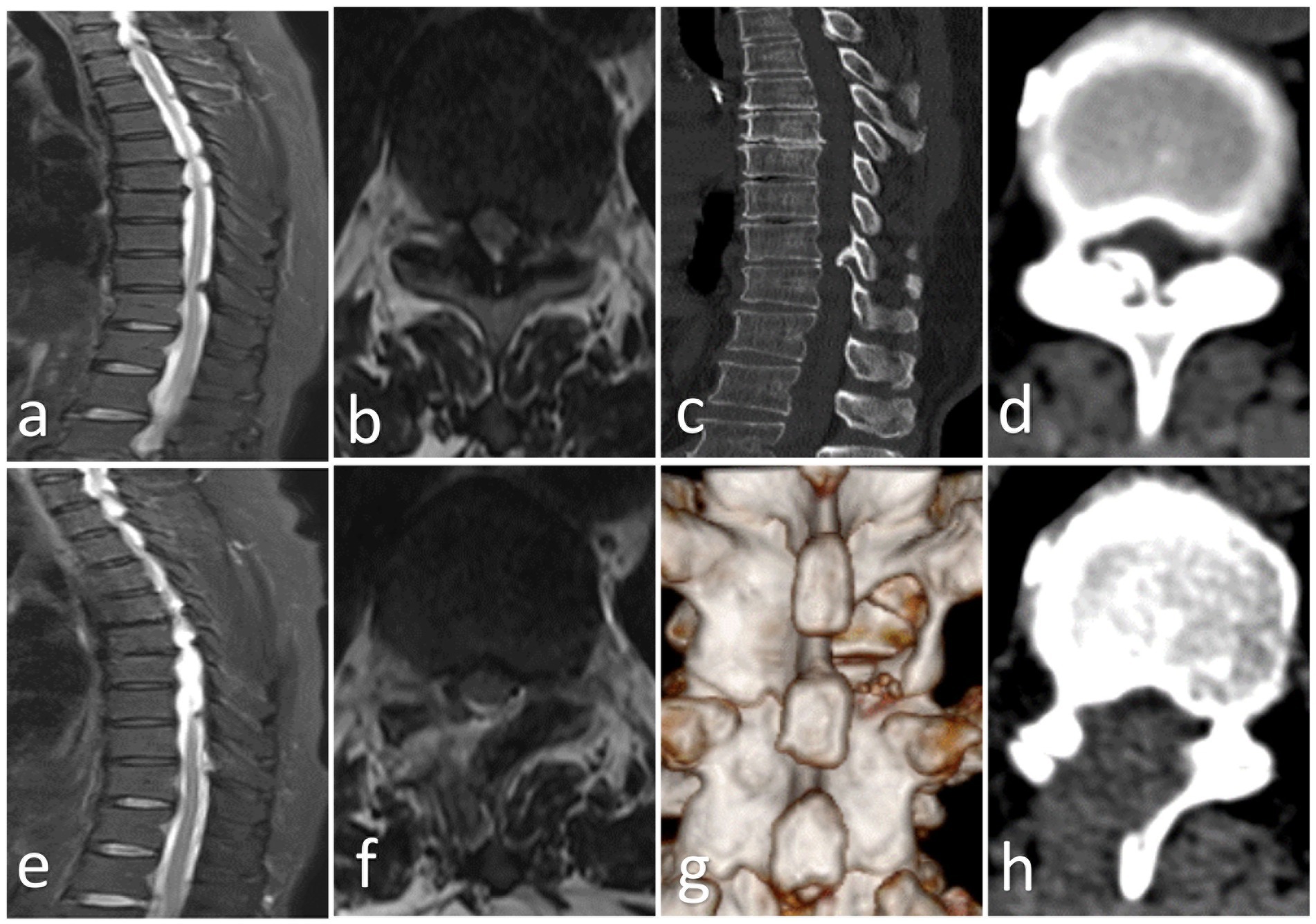
Figure 3. (a,b) Preoperative MRI shows ossification of the thoracic ligamentum flavum (Beak); (c,d) Preoperative CT shows ossification of the thoracic ligamentum flavum (Enlarged); (e,f) Postoperative CT shows that the ossification has been removed and spinal cord decompression has been successful; (g,h) Postoperative CT and 3D reconstruction show that the spinal canal has been opened and the ossification has been removed.
Evaluation index
Patient age, sex, surgical segment, hospitalization time, operative time and associated complications were recorded. Neurological status, both preoperatively and postoperatively, was evaluated using the mJOA score, the ASIA sense score (ASS), and the ASIA motor score of the lower extremities (AMS). The recovery rate (RR) was calculated as follows: RR = (postoperative JOA-preoperative JOA)/(11-preoperative JOA) × 100%. The surgical results were divided into good (50–100%), fair (25–49%), unchanged (0–24%), or deteriorated (<0%) according to the RR.
T-OLF was classified on the basis of sagittal MRI and axial CT. T-OLF can be classified as lateral, extended, enlarged, fused, or nodular on axial CT or as round or beak on the basis of sagittal MR images. After surgery, the degree of nerve decompression and articular process wear will be evaluated via 3D CT and MRI of the thoracic spine. All patients were followed up for at least 1 year.
Statistical analysis
All the statistical analyses were performed using SPSS 22.0 software. The variables were statistically analyzed by the t test, and the chi-square test was used for categorical variables. A p value less than 0.05 was considered to indicate statistical significance.
Results
Basic information
All patients were followed up for an average of 12–24 months. 33 patients underwent UBE surgery, and 31 patients underwent PE surgery. There was no significant difference in baseline characteristics between the two groups (Table 1).
Clinical efficacy
Neurological function was significantly improved in both groups after surgery. Compared with the PE group, the UBE group had better postoperative clinical efficacy, and the difference was statistically significant (p < 0.05). According to the RR, 24 patients were classified as good in the UBE group, 20 were classified as good in the PE group, and no patients deteriorated in either group (Table 2). Postoperative CT and MRI revealed that spinal cord compression in patients in both the UBE and PE groups was improved.
Complications
Four patients in the PE group and 1 patient in the UBE group had dural sac tears. Three patients with upper thoracic vertebrae in the PE group presented transient neurological deficits, including a temporary decrease in muscle strength, which resolved within 24 h. All patients were discharged after conservative treatment.
Discussion
T-OLF of the spine progresses insidiously over a long period of time and can eventually cause myeloradiculopathy and pain (17). The standard surgical method for the treatment of T-OLF is resection of the posterior wall of the thoracic spinal canal (18). By removing the lamina of the corresponding segment and the medial half of the bilateral facet joints, along with the ossified ligamentum flavum, dorsal spinal cord compression can be fully relieved, and symptoms can be alleviated. The minimally invasive treatment of T-OLF is a feasible and promising surgical approach (19). Compared with traditional surgery, minimally invasive techniques operate within a continuous saline environment, utilizing the magnification provided by the endoscope to clearly identify anatomical structures (20). Additionally, these techniques offer advantages such as less trauma, reduced bleeding, minimized soft tissue damage, decreased impact on the spinal activity unit, and rapid recovery (21).
In our study, there was no significant difference in operation time or postoperative hospital stay between the two groups. However, in the PE group, local anesthesia was used, and the operator monitored the spinal nerve status through communication with conscious patients, which reduced the risk of iatrogenic nerve injury. In the UBE group, general anesthesia was used, requiring additional doctors to assess the spinal cord nerve status through neuroelectrophysiological monitoring during the operation, which increased medical expenses and, consequently, the economic burden on patients.
The mJOA scores, ASS scores, and AMS scores of the two groups in our study significantly improved compared with the preoperative values, both 3 days postsurgery and at the final follow-up. Therefore, we believe that both PE and UBE are effective in achieving spinal nerve decompression and relieving patients’ symptoms. Furthermore, compared with the PE group, the UBE group demonstrated superior postoperative clinical efficacy. This may be attributed to the fact that UBE avoids the limitations of the coaxial field of vision seen with PE by establishing two separate channels, thereby widening the field of view. The unfixed hard channel allows for greater and more flexible instrument movement, facilitating the removal of contralateral bone and ossified tissue.
Previous studies have indicated that dural sac tears are the most common complication in T-OLF surgery, and our findings corroborate these results (22, 23). However, the incidence of dural sac tears was greater in the PE group (4 patients) than in the UBE group (1 patient). This may be due to the uncertainties associated with using trephine and Endo-Kerrison instruments in the PE group, particularly when using the Endo-Kerrison to remove thin ossification under coaxial visualization. Accurately determining whether adhesion exists between the dura and the ossification can be challenging, which hinders the flexible removal of ossification. The UBE procedure effectively separates the working channel from the observation channel, enabling precise visualization, which reduces the incidence of dural tears. Therefore, we believe that UBE offers greater flexibility and precision in the removal of ossified material in patients with OLF accompanied by dural ossification. In cases of tight adhesion between the ossified material and the dural sac, it also allows complete “floating” of the spinal cord.
Although the clinical results of this study are satisfactory, the risk associated with surgical procedures in the upper thoracic vertebrae is greater. In our study, 6 patients in the UBE group had upper T-OLF, and none experienced postoperative neurological deficits. In the PE group, 5 patients had T-OLF in the upper thoracic vertebrae, and 3 of them experienced postoperative neurological deficits. The possible reason is that in PE, a circular saw is used to remove the ossified ligamentum flavum. The accuracy of circular saw resection is highly dependent on the surgeon’s experience, increasing the difficulty and uncertainty of the procedure and leading to a higher incidence of nerve neurostimulation. Therefore, we suggest that the upper thoracic vertebrae should preferentially be treated with UBE. Compared with the PE procedure, UBE offers greater stability. The use of a grinding drill in UBE for thoracic vertebral bone removal provides high controllability, a more precise decompression range, less spinal cord or nerve interference, and greater safety.
Our study has several limitations. First, patients with extralarge-type OLF and those with OLF at multiple vertebral levels were excluded, which may introduce publication bias regarding complications and operation time. Second, the sample size was small, and the follow-up period was relatively short. Multicenter, long-term follow-up studies are necessary to gather more robust clinical data in the future.
Conclusion
For patients with T-OLF, both UBE and PE can effectively alleviate nerve compression and relieve symptoms. UBE uses two channels for observation and operation, which offers greater flexibility and allows for the continuous use of a grinding drill for bone decompression, leading to more effective and safer clinical outcomes.
Data availability statement
The raw data supporting the conclusions of this article will be made available by the authors, without undue reservation.
Ethics statement
The studies involving humans were approved by the Medical Ethics Committee of the Third People’s Hospital of Henan Province. The studies were conducted in accordance with the local legislation and institutional requirements. The participants provided their written informed consent to participate in this study. Written informed consent was obtained from the individual(s) for the publication of any potentially identifiable images or data included in this article.
Author contributions
YW: Writing – original draft, Formal analysis, Visualization, Validation. ZT: Writing – original draft, Formal analysis. QT: Investigation, Conceptualization, Writing – original draft. HM: Resources, Funding acquisition, Writing – original draft. MS: Formal analysis, Writing – original draft, Data curation. HY: Writing – review & editing, Funding acquisition, Writing – original draft, Visualization, Resources, Validation.
Funding
The author(s) declare that no financial support was received for the research and/or publication of this article.
Acknowledgments
We highly acknowledge the contribution by all the doctors in our department.
Conflict of interest
The authors declare that the research was conducted in the absence of any commercial or financial relationships that could be construed as a potential conflict of interest.
Generative AI statement
The authors declare that no Gen AI was used in the creation of this manuscript.
Publisher’s note
All claims expressed in this article are solely those of the authors and do not necessarily represent those of their affiliated organizations, or those of the publisher, the editors and the reviewers. Any product that may be evaluated in this article, or claim that may be made by its manufacturer, is not guaranteed or endorsed by the publisher.
References
1. Zhao, Y, Xiang, Q, Jiang, S, Wang, L, Lin, J, Sun, C, et al. Prevalence, diagnosis, and impact on clinical outcomes of dural ossification in the thoracic ossification of the ligamentum flavum: a systematic review. Eur Spine J. (2023) 32:1245–53. doi: 10.1007/s00586-023-07625-4
2. Fan, T, Sun, C, Chen, G, Jiang, S, Li, W, and Chen, Z. Clinical progression of ossification of the ligamentum flavum in thoracic spine: a 10- to 11-year follow-up study. Eur Spine J. (2023) 32:495–504. doi: 10.1007/s00586-022-07468-5
3. Hirabayashi, S. Ossification of the ligamentum flavum. Spine Surg Relat Res. (2017) 1:158–63. doi: 10.22603/ssrr.1.2016-0031
4. Zhao, Y, Xiang, Q, Jiang, S, Lin, J, Wang, L, Sun, C, et al. Incidence and risk factors of dural ossification in patients with thoracic ossification of the ligamentum flavum. J Neurosurg Spine. (2023) 38:131–8. doi: 10.3171/2022.7.SPINE22645
5. Yamada, T, Shindo, S, Yoshii, T, Ushio, S, Kusano, K, Miyake, N, et al. Surgical outcomes of the thoracic ossification of ligamentum flavum: a retrospective analysis of 61 cases. BMC Musculoskelet Disord. (2021) 22:7. doi: 10.1186/s12891-020-03905-y
6. Li, M, Meng, H, Du, J, Tao, H, Luo, Z, and Wang, Z. Management of thoracic myelopathy caused by ossification of the posterior longitudinal ligament combined with ossification of the ligamentum flavum-a retrospective study. Spine J. (2012) 12:1093–102. doi: 10.1016/j.spinee.2012.10.022
7. Ando, K, Imagama, S, Kaito, T, Takenaka, S, Sakai, K, Egawa, S, et al. Outcomes of surgery for thoracic myelopathy owing to thoracic ossification of the ligamentum Flavum in a Nationwide multicenter prospectively collected study in 223 patients: is instrumented fusion necessary? Spine. (2020) 45:E170–8. doi: 10.1097/BRS.0000000000003208
8. Guo, Q, Ni, B, Yang, J, Zhu, Z, and Yang, J. Simultaneous ossification of the posterior longitudinal ligament and ossification of the ligamentum flavum causing upper thoracic myelopathy in DISH: case report and literature review. Eur Spine J. (2011) 20:195–201. doi: 10.1007/s00586-010-1538-z
9. Yang, Z, Xue, Y, Zhang, C, Dai, Q, and Zhou, H. Surgical treatment of ossification of the ligamentum flavum associated with dural ossification in the thoracic spine. J Clin Neurosci. (2013) 20:212–6. doi: 10.1016/j.jocn.2012.02.028
10. Du, P, Ma, L, and Ding, W. The influence of ossification morphology on surgery outcomes in patients with thoracic ossification of ligamentum flavum (TOLF). J Orthop Surg Res. (2022) 17:229. doi: 10.1186/s13018-022-03064-x
11. Bian, F, Zhang, J, Bian, G, Wang, D, Chen, B, and An, Y. Comparison of the short-term efficacy of percutaneous endoscopic thoracic decompression and laminectomy in the treatment of thoracic ossification of the ligamentum Flavum. World Neurosurg. (2023) 170:e666–72. doi: 10.1016/j.wneu.2022.11.093
12. Deng, Y, Yang, M, Xia, C, Chen, Y, and Xie, Z. Unilateral biportal endoscopic decompression for symptomatic thoracic ossification of the ligamentum flavum: a case control study. Int Orthop. (2022) 46:2071–80. doi: 10.1007/s00264-022-05484-0
13. Yang, FK, Li, PF, Dou, CT, Yu, RB, and Chen, B. Comparison of percutaneous endoscopic thoracic decompression and posterior thoracic laminectomy for treating thoracic ossification of the ligamentum flavum: a retrospective study. BMC Surg. (2022) 22:85. doi: 10.1186/s12893-022-01532-z
14. Liu, Y, Li, X, Hou, Y, Leng, X, Yan, M, Chen, X, et al. Surgical outcomes of percutaneous endoscopic thoracic decompression in the treatment of multi-segment thoracic ossification of the ligamentum flavum. Acta Neurochir. (2023) 165:2131–7. doi: 10.1007/s00701-023-05603-9
15. Hua, W, Liao, Z, Chen, C, Feng, X, Ke, W, Wang, B, et al. Clinical outcomes of Uniportal and Biportal lumbar endoscopic unilateral Laminotomy for bilateral decompression in patients with lumbar spinal stenosis: a retrospective pair-matched case-control study. World Neurosurg. (2022) 161:e134–45. doi: 10.1016/j.wneu.2022.01.079
16. Feng, Z, Zhao, Z, Cui, W, Meng, X, and Hai, Y. Unilateral biportal endoscopic discectomy versus microdiscectomy for lumbar disc herniation: a systematic review and meta-analysis. Eur Spine J. (2024) 33:2139–53. doi: 10.1007/s00586-023-08116-2
17. Yu, L, Li, B, Yu, Y, Li, W, Qiu, G, and Zhao, Y. The relationship between Dural ossification and spinal stenosis in thoracic ossification of the ligamentum Flavum. J Bone Joint Surg Am. (2019) 101:606–12. doi: 10.2106/JBJS.17.01484
18. Pan, Q, Zhang, Z, Zhu, Y, Jiang, W, Su, K, Liu, P, et al. Zoning laminectomy for the treatment of ossification of the thoracic ligamentum flavum. Asian J Surg. (2023) 46:723–9. doi: 10.1016/j.asjsur.2022.06.118
19. Hou, X, Chen, Z, Sun, C, Zhang, G, Wu, S, and Liu, Z. A systematic review of complications in thoracic spine surgery for ossification of ligamentum flavum. Spinal Cord. (2018) 56:301–7. doi: 10.1038/s41393-017-0040-4
20. Wang, H, Wei, F, Long, H, Han, G, Sribastav, SS, Li, Z, et al. Surgical outcome of thoracic myelopathy caused by ossification of ligamentum flavum. J Clin Neurosci. (2017) 45:83–8. doi: 10.1016/j.jocn.2017.07.008
21. Kumar, V, Bansal, P, Ksheerasagar, VP, and Dhatt, SS. Comparison of endoscopic decompression to open laminectomy in patients with thoracic ossified ligamentum flavum—a systematic review and meta-analysis. Neurosurg Rev. (2024) 47:345. doi: 10.1007/s10143-024-02591-x
22. Yu, S, Wu, D, Li, F, and Hou, T. Surgical results and prognostic factors for thoracic myelopathy caused by ossification of ligamentum flavum: posterior surgery by laminectomy. Acta Neurochir. (2013) 155:1169–77. doi: 10.1007/s00701-013-1694-0
Keywords: thoracic ossification of the ligamentum flavum, unilateral biportal endoscopic, percutaneous endoscopic, clinical efficacy, minimally invasive spine surgery
Citation: Wang Y, Tang Z, Tang Q, Ma H, Shen M and Yang H (2025) Comparison of the clinical efficacy and safety of two spinal endoscopic techniques for the treatment of ossification of the ligamentum flavum in the thoracic spine. Front. Neurol. 16:1630315. doi: 10.3389/fneur.2025.1630315
Edited by:
Pei Shang, Mayo Clinic, United StatesCopyright © 2025 Wang, Tang, Tang, Ma, Shen and Yang. This is an open-access article distributed under the terms of the Creative Commons Attribution License (CC BY). The use, distribution or reproduction in other forums is permitted, provided the original author(s) and the copyright owner(s) are credited and that the original publication in this journal is cited, in accordance with accepted academic practice. No use, distribution or reproduction is permitted which does not comply with these terms.
*Correspondence: Hejun Yang, aGVqdW55YW5nMDJAMTYzLmNvbQ==
 Yupeng Wang
Yupeng Wang Zhongxin Tang
Zhongxin Tang